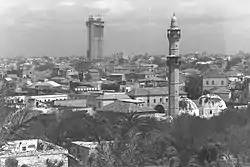| Shalom Meir Tower | |
|---|---|
מגדל שלום מאיר | |
 | |
| General information | |
| Status | Completed |
| Type | Government, Commercial, Residential |
| Location | |
| Coordinates | 32°3′50.47″N 34°46′11.18″E / 32.0640194°N 34.7697722°E |
| Construction started | 1963 |
| Opening | 1965 |
| Height | |
| Roof | 142 metres (466 ft) |
| Technical details | |
| Floor count | 34 |
| Design and construction | |
| Architect(s) | Yitzhak Pearlstein, Gideon Ziv, Meir Levy |
| Structural engineer | Eliezer Dushnitzky |
Shalom Meir Tower (Hebrew: מגדל שלום מאיר, Migdal Shalom Meir; commonly known as Migdal Shalom, Hebrew: מגדל שלום) is an office tower in Tel Aviv, Israel. It is Israel's first skyscraper.
Overview
Shalom Meir Tower was designed by architects Yitzhak Pearlstein, Gideon Ziv, and Meir Levy. Migdal Shalom has 34 floors and stands at a height of 142 metres (466 ft).[1][2]
50,000 cubic meters of concrete, 4,000 tons of steel, 35 km of water pipes, and 500 km of wiring were used in the tower.
When its construction was completed in 1965, it was the tallest building in the Middle East, as well as the tallest in Asia, and rivaled the tallest buildings in Europe in height. It was the last building in Western Asia to be the tallest building in Asia until the Burj Khalifa in Dubai was completed in 2010.
History


The tower was built on the site of the Herzliya Hebrew High School, better known as Herzliya Gymnasium. The school's architecturally and historically significant structure was razed and the school relocated in order to build the tower in 1962. This decision was later regretted and the contour of the Herzliya Gymnasium became the emblem of the Society for Preservation of Israel Heritage Sites (SPIHS).[3]
Construction was carried out by the Meir Brothers, Moshe, Mordechai and Menachem Meir, who named it after their father, Reb Shalom-Shachna Meir, born in Sanok in Galicia.[4] Shalom-Shachna Meir married the daughter of a rich manufacturer from the Romanian region of Moldova, where he lived until 1920, becoming a successful businessman as well as a leader of the local Zionists.[4] In 1920 he emigrated to Palestine where he became an important public figure in the early years of Tel Aviv, a member of the town's first city council, and one of the founders of Ramat Gan.[4]
The building has a cream hue tile facade which was created especially for the tower and was manufactured in Italy. A subway station was built under the tower block, but rails were never laid and the station remains empty and disconnected from any rail system.[5]
Artwork and exhibits
The ground-floor retail promenade features a mosaic mural by the Israeli artist Nachum Gutman[6][7] facing another one by David Sharir.[8] The Shalom Tower now houses the Tel Aviv Center comprising a number of permanent and temporary exhibitions dedicated to the beginnings and development of Tel Aviv.[9]
See also
References
- ↑ "Shalom Mayer Tower, Tel Aviv - Yaffo | 104855". Emporis. Archived from the original on April 26, 2004. Retrieved 2022-05-02.
- ↑ http://jpress.org.il/Default/Scripting/ArticleWin_TAU.asp?From=Archive&Skin=TAUHe&BaseHref=DAV/1965/07/09&EntityId=Ar01000&ViewMode=HTML (in Hebrew)
- ↑ What to see on Herzl Street, birthplace of the first modern Jewish city
- 1 2 3 Ascher Bit: Reb Shalom-Shachna Meir of blessed memory, translated by Jerrold Landau. On JewishGen.org, accessed 4 April 2016
- ↑ "Tel Aviv Light Rail Metro, Israel". Retrieved 23 December 2013.
- ↑ Shalom Tower Galleries: Nahum Gutman's Mosaic Wall
- ↑ "Mosaic Mural – Mosaic Artist – Nahum Gutman – Shalom Tower – Tel Aviv, Israel". 17 February 2007.
- ↑ Shalom Tower Galleries: David Sharir's Mosaic Wall
- ↑ Shalom Tower website: Discover Tel Aviv Center
External links
- Shalom Tower Galleries official website, English page
- Lappin, Yaakov (November 17, 2010). "Large Fire Breaks Out in Tel Aviv's Shalom Tower". The Jerusalem Post. Retrieved 2010-11-19.